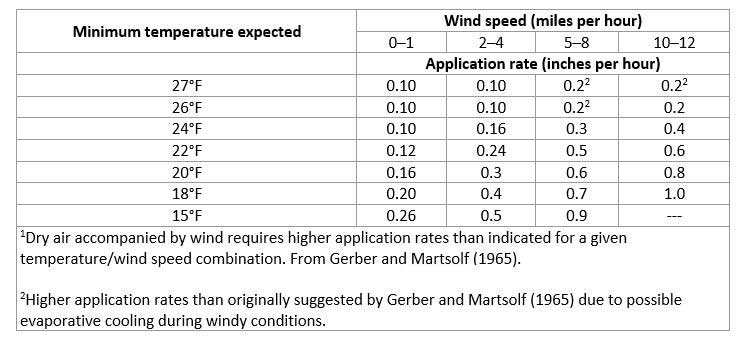Florida southern highbush blueberries need freeze protection to minimize damage to flower buds, blooms, and young fruit. This is typically done using overhead irrigation, which involves putting out large volumes of water to reduce the impact of cold temperatures on susceptible floral and fruit tissues.
Factors to consider in freeze protection
Dew Point – This is the temperature at which water vapor condenses, and can be an indicator of water vapor content in the air. A higher dew point is better during freezing conditions since water vapor slows the rate of radiant heat loss from the blueberry field. In contrast, a low dew point increases the rate of temperature drop, and can increase evaporative cooling during freeze protection.
Temperature – Freeze protection is typically begun when temperatures in a weather bureau shelter alongside the plants at flower-height level are at 32°F or below. However, dew point must also be considered, since a low dew point will result in a more rapid decrease in temperature. One measure that takes both air temperature and dew point into account is wet bulb temperature, which can be measured using a wet bulb thermometer. When temperatures are near freezing, an approximation of wet bulb temperature can be calculated by subtracting one-third of the difference between air temperature and dew point from the air temperature. For example, using an air temperature of 33°F and a dew point of 24°F, the wet bulb temperature would be 30°F. Overhead irrigation for freeze protection should typically begin when the wet bulb temperature is at or below 32°F.
Some growers begin freeze protection when the air temperature is 33°F – 35°F, preferring to begin at higher temperatures to avoid unexpected temperature drops to dangerous levels and accompanying yield loss. Beginning freeze protection above 32°F may be necessary in certain situations, including calm clear nights in lower-lying areas, to prevent the irrigation system from freezing during the night, and to account for a brief initial reduction in temperature when overhead irrigation is begun. There may also be variable topography at a farm that requires beginning protection when most of the farm is at a temperature above freezing, in order to protect the colder areas. In addition, several stages of bloom may be present on bushes at the same time, making the decision of when to begin freeze protection more complex (see discussion of floral development stage below).
If it is calm and sunny the morning following a freeze, the irrigation system can be turned off when icicles are falling rapidly from the bushes, and have been falling for at least 30 minutes. If the dew point is below 20°F, the irrigation system should remain on until the air temperature in the shade is 40°F. If it is windy and the dew point is 26°F or below, the system should remain on until most of the icicles have fallen.
Windspeed – Wind can be a significant problem during freeze protection. It not only increases evaporative cooling, it can also interfere with the distribution of water, resulting in uneven protection. However, if overhead irrigation is not being used wind can be beneficial, as it can prevent the formation of cold air pockets close to the ground under an inversion layer.
The volume of water (gallons per minute) needed for adequate freeze protection depends on air temperature, wind speed, dew point temperature, and irrigation system design. Table 1 presents some suggested overhead irrigation application rates for freeze protection based on temperature and wind speed. However, this table does not factor in the air’s water vapor content. When water vapor content and dew point are very low, higher application rates than those listed in Table 1 are typically required.
The Florida Automated Weather Network (FAWN) (https://fawn.ifas.ufl.edu/) maintains a series of weather stations throughout Florida, and is a resource for historical and current weather conditions, including temperature, dew point, and wind speed.
Floral Development Stage – Even mild damage to blueberry buds and blooms can result in significant reductions in yield. Completely dormant buds are very cold hardy, and tightly closed buds tend to be fairly cold-resistant. The potential for cold damage increases as the bloom progresses, with petal-fall and green fruit stages being the most susceptible to damage. Some growers determine the temperature to begin freeze protection based on a stage of development in order to save on diesel fuel costs and reduce water withdrawal from their wells. See Figure 1 for the different stages of bud and bloom development.

Site Conditions – Various site conditions can impact farm temperature. Farms with low-lying sections can experience lower temperatures since cold air will drain into lower areas, creating temperature differentials across a farm during clear, cold nights.
Pine bark mulch can result in lower air temperature by as much as 5°F by interfering with the transfer of heat from the ground. Dry soil will lower air temperature relative to wet soil due to its inability to replace water vapor lost through frost formation, and by being a poor conductor of heat from the ground. In certain situations, it may be helpful to irrigate fields the afternoon before an expected freeze, with the goal of raising soil moisture and minimum field temperatures.
For additional details on freeze protection for blueberries in Florida, see UF EDIS Publications HS968, Protecting Blueberries from Freezes in Florida (https://edis.ifas.ufl.edu/pdffiles/HS/HS21600.pdf) and FE979, Improving the Precision of Blueberry Frost Protection Irrigation (https://edis.ifas.ufl.edu/pdffiles/FE/FE97900.pdf), and the Winter Freeze Checklist in the fall 2018 issue of The Blueberry News.
Table 1.
Suggested overhead irrigation application rates for cold protection of blueberries under different wind and temperature conditions1

by Doug Phillips, UF Blueberry Extension Coordinator






